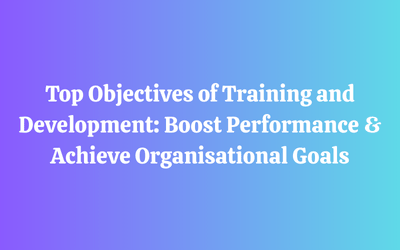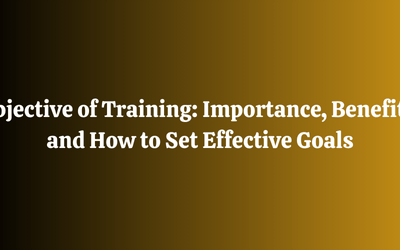Developing an effective training program requires a structured, step-by-step approach. One-time training sessions often fail to meet employee expectations and organizational goals. Instead, businesses should focus on continuous training, integrating interactive training, technology-based learning, and competency-based learning to ensure long-term success.
In this guide, we’ll explore the five key steps to creating successful employee training programs, with real-world scenarios, a checklist format, and SEO-optimized headings for better comprehension.
Why Effective Training Programs Matter
The Benefits of Training Programs
A well-designed employee training program improves:
✅ Employee performance – Helps employees build critical skills, leading to better job performance.
✅ Employee retention rates – Reduces employee turnover by providing growth opportunities.
✅ Customer satisfaction – Enhances customer service training, leading to improved customer loyalty.
✅ Business outcomes – Aligns with business objectives to support long-term company growth.
📊 Example: A sales team that receives structured negotiation skills and customer education training will likely close more deals and improve customer relationships.
Step 1: Analyze Your Training Needs
Identify Performance Gaps
Start by assessing skills gaps through:
🔹 Employee feedback (surveys, performance reviews)
🔹 Performance appraisal data
🔹 Competency-based learning evaluations
🔹 Leadership training program assessments
📌 Real-World Scenario: A marketing team notices declining customer engagement. A skills assessment reveals a gap in digital marketing knowledge, leading to a technical training program on social media advertising.
✅ Checklist for Training Needs Analysis:
☑ Define business objectives
☑ Identify employee performance gaps
☑ Assess organizational goals
☑ Collect feedback from employees
Step 2: Set Training Goals & Objectives
Training objectives should align with business goals and focus on:
🔹 Improving soft skills (e.g., emotional intelligence training)
🔹 Addressing technical skills gaps
🔹 Supporting career development and professional growth
🔹 Meeting compliance standards (compliance training)
📌 Example: A customer service team needs to improve conflict resolution. A customer service training program with role-playing exercises helps them develop better communication strategies.
✅ Checklist for Setting Training Goals:
☑ Define the goal of training
☑ Align with organizational performance metrics
☑ Consider learning styles (Blended learning, Self-Directed Learning)
☑ Set measurable training objectives
Step 3: Design & Develop the Training Program
Types of Employee Training
Different training methods work for different industries:
🔹 Instructor-led training – Ideal for leadership training
🔹 Online training – Great for remote teams (digital transformation)
🔹 Hands-on training – Best for technical training
🔹 Classroom-based training – Useful for soft skills and safety training
🔹 Interactive training – Uses simulations and interactive elements
📌 Example: A technology company implements technology-based learning through online courses and virtual reality simulations to train employees on new software tools.
✅ Checklist for Training Program Design:
☑ Select training types that suit your business activities
☑ Choose training materials (videos, quizzes, case studies)
☑ Incorporate interactive elements (e.g., role playing, gamification)
☑ Develop training plans with clear timelines
Step 4: Implement & Deliver the Training
Once the training content is ready, execution is key.
🔹 Pilot program – Test training on a small group before full rollout
🔹 On-the-job training – Apply knowledge in real-world settings
🔹 Continuous learning – Offer ongoing training opportunities
🔹 Leadership development – Train future leaders through mentorship
📌 Example: A company launches a leadership training program for senior managers to help them transition into executive roles.
✅ Checklist for Training Implementation:
☑ Define the delivery method (in-person training, online training, etc.)
☑ Schedule training sessions at convenient times
☑ Ensure access to training resources (videos, guides, simulations)
☑ Track employee participation and engagement
Step 5: Evaluate & Improve Training Programs
Training evaluation is crucial to measure the effectiveness of training and make improvements.
🔹 Employee feedback – Use constructive feedback surveys
🔹 Performance tracking – Measure job performance improvements
🔹 Business outcomes – Assess impact on business objectives
🔹 Retention rates – Check if lack of training affects employee retention
📌 Example: A sales team that completed customer education training sees a 10% increase in conversion rates, proving the training effectiveness.
✅ Checklist for Training Evaluation:
☑ Gather employee feedback on training sessions
☑ Measure job satisfaction and employee growth
☑ Assess the effectiveness of employee training programs
☑ Identify areas for improvement and update training content
Final Thoughts
Developing an effective training program requires strategic planning, continuous learning, and regular evaluation. By aligning training programs with business goals, companies can improve employee performance, customer satisfaction, and organizational performance.
📢 Ready to enhance your employee training programs? Start implementing these steps today!
Key Takeaways
🔹 Employee training is essential for career development and business growth.
🔹 Training programs should be interactive, practical, and aligned with business objectives.
🔹 Continuous training and feedback loops help optimize training effectiveness.
🚀 By investing in structured training initiatives, businesses can drive long-term success and employee satisfaction.
Learn More
Our News
- AI
- Animations
- Articulate
- Articulate 360
- Articulate Engage
- Articulate Live
- Articulate Presenter
- Articulate Quizmaker
- Articulate Replay
- Articulate Review
- Articulate Storyline
- Articulate Storyline 3
- Articulate Studio
- bite sized learning
- Characters
- Content Library
- Corporate Communication
- E-Learning
- e-Learning Authoring Tools
- Employee Engagement
- Game-Based Learning
- Gamification
- Gamiflexer
- Go Sales
- Healthcare
- Instructional Design
- Interactivity
- Knowledge Transfer
- L&D Trends
- Learning
- Learning & Development
- Learning Experience platform
- Learning Management System
- LMS
- LXP
- Microlearning
- mLearning
- Mobile Learning
- Nugget Learning
- Online Training
- Peek
- Performance Support
- Preso
- Quiz and Assessment Platform
- Replay 360
- Rise
- SCORM
- Screen Capture
- Software
- Storyline 360
- Studio 360
- Training Management
- Trainings
- Uncategorized




